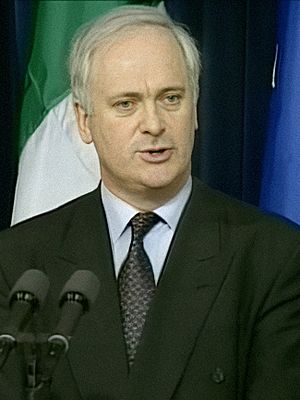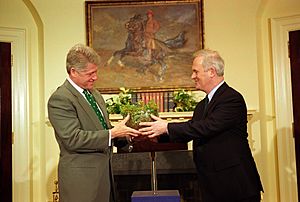John Bruton facts for kids
Quick facts for kids
John Bruton
|
|
|---|---|

Bruton in 1996
|
|
| 10th Taoiseach | |
| In office 15 December 1994 – 26 June 1997 |
|
| President | Mary Robinson |
| Tánaiste | Dick Spring |
| Preceded by | Albert Reynolds |
| Succeeded by | Bertie Ahern |
| European Union Ambassador to the United States | |
| In office 24 November 2004 – 31 October 2009 |
|
| President | José Manuel Barroso |
| Preceded by | Günter Burghardt |
| Succeeded by | Angelos Pangratis (acting) |
| Leader of the Opposition | |
| In office 26 June 1997 – 9 February 2001 |
|
| President |
|
| Taoiseach | Bertie Ahern |
| Preceded by | Bertie Ahern |
| Succeeded by | Michael Noonan |
| In office 20 November 1990 – 15 December 1994 |
|
| President |
|
| Taoiseach |
|
| Preceded by | Alan Dukes |
| Succeeded by | Bertie Ahern |
| Leader of Fine Gael | |
| In office 21 November 1990 – 9 February 2001 |
|
| Deputy |
|
| Preceded by | Alan Dukes |
| Succeeded by | Michael Noonan |
| Deputy leader of Fine Gael | |
| In office 26 March 1987 – 20 November 1990 |
|
| Leader | Alan Dukes |
| Preceded by | Peter Barry |
| Succeeded by | Peter Barry |
| Minister for the Public Service | |
| In office 20 January 1987 – 10 March 1987 |
|
| Taoiseach | Garret FitzGerald |
| Preceded by | Ruairi Quinn |
| Succeeded by | Alan Dukes |
| Minister for Finance | |
| In office 14 February 1986 – 10 March 1987 |
|
| Taoiseach | Garret FitzGerald |
| Preceded by | Alan Dukes |
| Succeeded by | Ray MacSharry |
| In office 30 June 1981 – 9 March 1982 |
|
| Taoiseach | Garret FitzGerald |
| Preceded by | Gene Fitzgerald |
| Succeeded by | Ray MacSharry |
| Minister for Industry, Trade, Commerce and Tourism | |
| In office 13 December 1983 – 14 February 1986 |
|
| Taoiseach | Garret FitzGerald |
| Preceded by | Garret FitzGerald (acting) |
| Succeeded by | Michael Noonan |
| Minister for Industry and Energy | |
| In office 14 December 1982 – 13 December 1983 |
|
| Taoiseach | Garret FitzGerald |
| Preceded by | Albert Reynolds |
| Succeeded by | Dick Spring |
| Parliamentary Secretary | |
| 1973–1977 | Industry and Commerce |
| 1973–1977 | Education |
| Teachta Dála | |
| In office June 1969 – 31 October 2004 |
|
| Constituency | Meath |
| Personal details | |
| Born | 18 May 1947 Dunboyne, County Meath, Ireland |
| Died | 6 February 2024 (aged 76) Dublin, Ireland |
| Political party | Fine Gael |
| Spouse |
Finola Gill
(m. 1978) |
| Children | 4 |
| Relatives | Richard Bruton (brother) |
| Education | Clongowes Wood College |
| Alma mater |
|
John Gerard Bruton (18 May 1947 – 6 February 2024) was an important Irish politician. He was the Taoiseach (Prime Minister) of Ireland from 1994 to 1997. He also served as the Leader of Fine Gael, a major political party, from 1990 to 2001.
Bruton was a Teachta Dála (TD), which is a member of the Irish Parliament (Dáil Éireann), for the Meath area from 1969 to 2004. After his time as Taoiseach, he became the Ambassador of the European Union to the United States from 2004 to 2009. He led a government known as the "Rainbow Coalition" with the Labour Party and Democratic Left.
Contents
Early Life and Education
John Gerard Bruton was born on 18 May 1947 in Dunboyne, County Meath, Ireland. He came from a farming family.
He went to school at Clongowes Wood College. Later, he studied at University College Dublin (UCD) and became a barrister from King's Inns. A barrister is a type of lawyer, but John Bruton never actually worked as one.
In 1978, John Bruton married Finola Gill, and they had four children together. He passed away in Dublin on 6 February 2024, when he was 76 years old.
Starting in Politics
John Bruton was first elected to the Dáil Éireann in 1969. He was only 22 years old, making him one of the youngest members of the Dáil at that time.
In 1973, his party, Fine Gael, formed a government with the Labour Party. Bruton was given important roles as a Parliamentary Secretary (a junior minister) in the areas of Industry and Commerce, and Education. He held these roles until 1977.
Key Government Roles
After 1977, when Fine Gael was no longer in government, John Bruton became a spokesperson for his party on important topics like Agriculture and Finance. He was known for his strong speeches in the Dáil.
In 1981, Fine Gael and the Labour Party formed another government. At just 34 years old, Bruton was appointed Minister for Finance. This is a very senior job, in charge of the country's money and budget.
His government faced tough economic times. In 1982, his budget was not approved by the Dáil, and the government had to step down.
More Ministerial Roles
Later in 1982, Fine Gael returned to power. Bruton became Minister for Industry and Energy. In 1983, his role changed slightly to Minister for Industry, Trade, Commerce and Tourism.
In 1986, he was again appointed Minister for Finance. However, the government collapsed before he could present his budget, due to disagreements with the Labour Party.
Leading Fine Gael
After a difficult election for Fine Gael in 1987, the party's leader, Garret FitzGerald, resigned. John Bruton ran for the leadership but lost to Alan Dukes. Bruton then became the Deputy Leader of Fine Gael.
In 1990, Alan Dukes resigned as leader after a poor election result for the party. John Bruton then became the new leader of Fine Gael without anyone running against him.
When he became leader, Fine Gael had been losing support for many years. Bruton aimed to rebuild the party. In the 1992 election, Fine Gael did not gain as many seats as hoped, and the Labour Party chose to form a government with Fianna Fáil instead. This was a big disappointment for Bruton.
His position as leader was challenged in 1994, but he managed to keep his role after some good election results for Fine Gael.
Taoiseach (1994–1997)
In late 1994, the government led by Albert Reynolds of Fianna Fáil collapsed. John Bruton was able to convince the Labour Party to leave their coalition with Fianna Fáil. Instead, they formed a new government with Fine Gael and Democratic Left.
On 15 December 1994, John Bruton became the Taoiseach. He was 47 years old, making him one of the youngest Taoisigh at that time. This was also the first time in Ireland's history that a new government was formed without a general election.
Northern Ireland Peace Process
A very important part of Bruton's time as Taoiseach was his work on the Northern Ireland peace process. In 1995, he worked with the British Prime Minister, John Major, to create the 'Framework Document'. This document suggested new ways for Ireland, Northern Ireland, and the United Kingdom to work together.
Some people thought Bruton was too willing to agree with unionist demands. However, he also strongly criticized the British Government for not talking enough with Sinn Féin during the IRA ceasefire.
Bruton also tried to work with Gerry Adams of Sinn Féin, even though they did not fully trust each other. Relations became difficult when the IRA ceasefire ended in 1996, leading to bombings in London and Manchester. Bruton was praised for speaking out against the police in Northern Ireland (Royal Ulster Constabulary) when they allowed a controversial parade by the Orange Order through a nationalist area.
European Union and Other Issues
Bruton's government also had a successful period leading the European Union in 1996. He helped to create the Stability and Growth Pact, which sets rules for countries using the euro currency.
In 1996, John Bruton was the fifth Irish leader to speak to the joint session of the United States Congress. This showed the strong relationship between Ireland and the USA.
During his time as Taoiseach, there were some challenges. One minister resigned due to questions about his finances. There were also allegations made later about improper payments related to planning decisions, which Bruton denied.
Bruton also welcomed Charles, Prince of Wales (now King Charles III) on the first official visit by a member of the British Royal Family since 1912. Bruton saw this visit as a big step forward in Anglo-Irish relations.
After the murder of crime journalist Veronica Guerin, his government set up the Criminal Assets Bureau. This agency helps to take away money and property gained from crime.
After Being Taoiseach
In the 1997 general election, Fine Gael gained seats, but their coalition partner, Labour, lost many. This meant Bruton's government could not continue, and he resigned. Bertie Ahern became the new Taoiseach, and Bruton returned to being the Leader of the Opposition.
In 2001, John Bruton was replaced as leader of Fine Gael by Michael Noonan. This happened because there were worries that the party would lose many seats in the next election.
Bruton was a strong supporter of European integration. He was chosen to be one of Ireland's representatives to the Convention on the Future of Europe, which helped to write the proposed European Constitution.
In 2004, he became the European Union Ambassador to the United States. He resigned from the Dáil to take up this important role.
John Bruton often gave lectures at universities around the world. In 2008, he received an award called the Order of the Polar Star from the Government of Sweden.
His brother, Richard Bruton, is also a politician for Fine Gael and has held several government roles.
In 2009, John Bruton expressed interest in becoming the President of the European Council, a top job in the European Union, but Herman Van Rompuy was chosen for the role.
In 2010, he became the chairman of IFSC Ireland, a new group that promotes Ireland as a good place for international financial services.
In 2014, on the 100th anniversary of a historical Irish law, Bruton shared his view that the 1916 Easter Rising was a mistake.
Government
- 24th Government of Ireland (December 1994 – June 1997)
Images for kids
-
Bruton giving a bowl of Shamrocks to President Bill Clinton on Saint Patrick's Day, 1995
See also
 In Spanish: John Bruton para niños
In Spanish: John Bruton para niños



